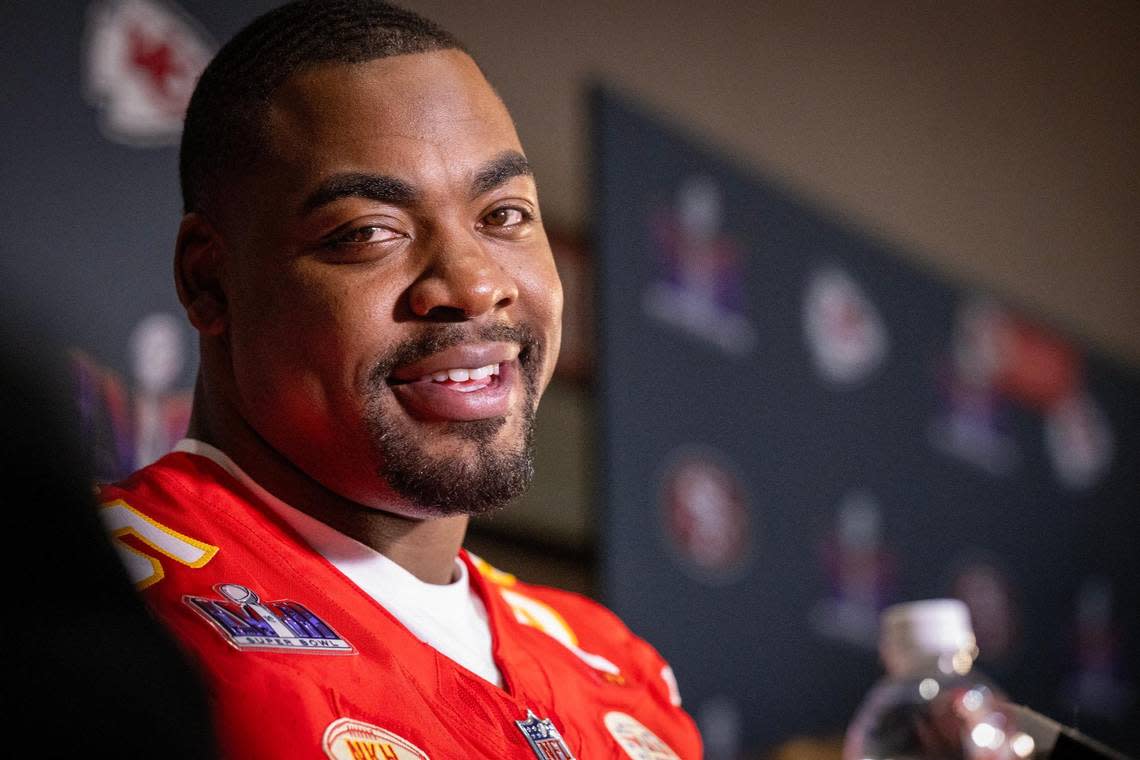Chris Jones’ contract is a deal the Chiefs usually avoid. Why they made an exception

- Oops!Something went wrong.Please try again later.
- Oops!Something went wrong.Please try again later.
- Oops!Something went wrong.Please try again later.
- Oops!Something went wrong.Please try again later.
- Oops!Something went wrong.Please try again later.
- Oops!Something went wrong.Please try again later.
Two days before the onset of NFL free agency, the Chiefs plucked the biggest name off the market.
Kept the biggest name off the market.
That’s the pivotal word that turns their massive decision into a massive distinction.
The Chiefs gave impending free-agent defensive tackle Chris Jones a five-year extension Saturday, sources confirmed. ESPN first reported the deal. The full structure is still to be revealed, but there are $95 million in guarantees tied into the first three years, multiple sources told me, which basically means it will function more like a three-year contract.
It’s a pricey arrangement to keep one of their own.
But let’s be clear: This extension is not more of the same.
It’s a departure — a sharp departure, at that — from the blueprint that has guided KC’s recent offseasons. The Chiefs’ dynasty has been defined by its willingness to adapt, not the urge to keep the band together.
But late Saturday night, the Chiefs told us (for the first time in this era) that philosophy stretches only so far. There is a bar after all — an All-Pro, future Hall of Fame bar — and the Chiefs quite evidently believe Jones clears it.
That makes this the biggest wager the Chiefs have taken in the Patrick Mahomes dynasty era, and the type of wager they have avoided in the past — putting a 30-year-old player on a multi-year contract. Jones will turn 30 in July, before the 2024 season begins, meaning the guaranteed portion of his contract will cover his age 30, 31 and 32 seasons.
To be sure, the Chiefs have paid Jones handsomely and won Super Bowls while doing it. But they’ve never paid him quite like this, or more notably at this age; and the extension comes when they are set to pay Mahomes like they never have, either.
The Chiefs put Jones into a category previously occupied only by Travis Kelce: 30-year-olds receiving multi-year raises.
Hence the wager. The risk, even.
Why the exception? Well, the Chiefs believe there is a limit to whom they can play without, a limit to what Mahomes can cover up.
That limit is the other side of the football. When the Chiefs traded Tyreek Hill, they had the Mahomes and Kelce fallback. Jones is the Mahomes of the defense, the axis on which everyone else spins. More on that in a minute.
The wager piece of it is whether he can continue to be, because the Chiefs have been careful to pay for future projections rather than reward past contribution. Their cap is such that paying a 30-year-old that kind of money almost has to work out. They do not have the funds to cover up mistakes.
There are interior defensive linemen who have played good football into their 30s. Cameron Heyward had at least 58 pressures at age 30, 31, 32 and 33. Aaron Donald is still playing at a high level at 32.
There are a few others, but the data shows Jones is nearing an age in which those who play his position start to see a decline. The Chiefs are making an exception for Jones now, and banking that he provides the exception over the next three years.
Their argument is structured like this. He’s already unlike his peers, so they believe he will continue to be. He seemingly arrives to every season in better shape than the last. And two of his very best seasons are the two most recent, when he finished first (2022) and second (2023) in pressures among interior defensive linemen per PFF data.
Remarkably, that’s despite facing the most double teams in the league over that span. He tied Aaron Donald with a 20% pass rush win rate, per ESPN Analytics, but was double-teamed on 72% (!) of his snaps.
Which actually brings up an interesting aspect: Jones’ reputation alone, even before you advance the conversation to his production, offers a benefit. I said this a year ago when the Chiefs and Jones were locked into a contract dispute that kept him out of training camp, but there’s a reason edge rushers tend to put up some numbers when Jones is occupying the middle.
It’s why, I argued then, that Jones has more value in Kansas City than Hill ever did.
That sentence now has more of a literal meaning to it.
The Chiefs have always had this kind of bar in their minds, it turns out — Hall of Fame-caliber players would always break their mold — but it’s just been hidden from public view. They haven’t changed their big-picture thinking, some insisted in conversations over the last 24 hours, but rather found the player who publicized their exceptions.
They’ve made one.
Much of their future is now tied into a belief that needs Jones to continue to be one.
